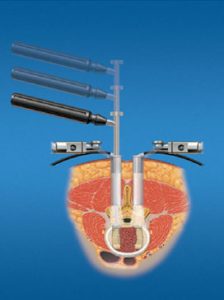Minimally Invasive Percutaneous Spine Surgery
For Back and Leg Pain Relief
Surgery of the spine can often be performed through either an open surgical approach or a minimally invasive approach.
There are advantages in some cases to having a lumbar surgery performed through a minimally invasive approach, while in some cases it is best to use the traditional open surgical approach.
Some procedures that lend themselves to minimally invasive surgery include:
• Lumbar Discectomy/Cervical Discectomy
• Lumbar Fusion/Cervical Fusion
• Lumbar Laminectomy/Cervical Laminectomy
As the technologies and surgical instrumentation for minimally invasive surgery continue to improve, so will this approach be used more often in lumbar procedures. Be sure to ask your neurosurgeon which surgery option is best for your particular condition.

Minimally invasive surgery has been shown to offer the patient:
• Less overall stress
• Shorter hospital stays
• Less postoperative pain
• Less blood loss
• Smaller scars
• Less damage to muscle and skin
• Faster and easier rehabilitation
• Quicker return to normal activities
With the minimally invasive option, the neurosurgeon uses multiple small incisions rather than the traditional long midline incision of open surgery, and the surgeon splits (spreads) muscle fibers rather than strips them away from the bone. As a result, hospital stays may be shorter.
X-ray guidance (fluoroscopy) is used much more intensively during minimally invasive procedures on the spine.
With large open incisions, the surgeon can expose much of the spinal anatomy and use anatomical features as a reference for guidance. With minimally invasive approaches, the surgeon arrives at certain points in the spine through very small skin incisions guided significantly by the use of live x-ray imaging in the operating room.
Minimally invasive fusions can also be accomplished with the use of extensive live x-ray imaging in the operating room. The C arm is an x-ray device that allows the surgeon to see, in real-time, where his instruments are going relative to the spine. Pedicle screws can be placed into the spine using this technique.
Many instrument sets have been designed to facilitate minimally invasive fusions. One such example is the Sextant device, which allows the spine surgeon to first place screws into the pedicles of the spine, then attach a device to the screws which helps the surgeon tunnel a rod through a small opening in the skin, and cast the rod through the screws inserted into the spine, thus allowing for very stable construct.
As technology advances, the options for approaches to the spine increase. The skilled spine surgeon can advise which situations are treatable with a minimally invasive approach and which are best treated with a more open approach.
The postoperative care in a hospital after a minimally invasive approach to the spine is often shorter than that with an open approach. The patients will need to maintain good wound care, keeping the wound dry for 10 to 12 days.
The wounds are usually closed with a type of medical glue, instead of more traditional staples or sutures. Otherwise, patients with lumbar surgeries and neck surgery should avoid significant straining, bending, twisting or lifting, and the imposition of restrictions will vary depending upon the type of surgery.
Like traditional open surgeries, minimally invasive surgery has risks as well. Although the outside incision is different, the same type of procedure is usually performed on the inside with most minimally invasive surgeries, resulting in possible risks to the nerves in the area.